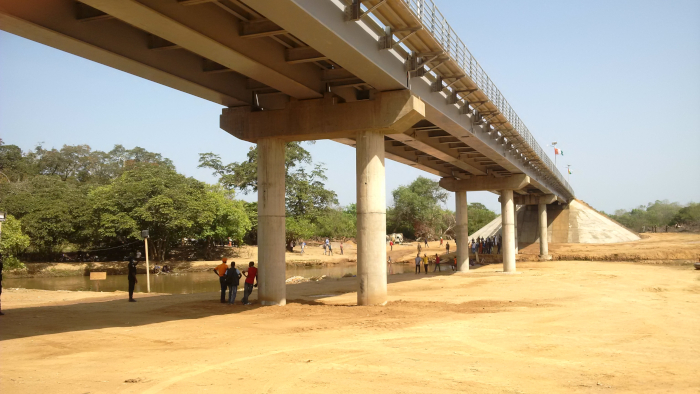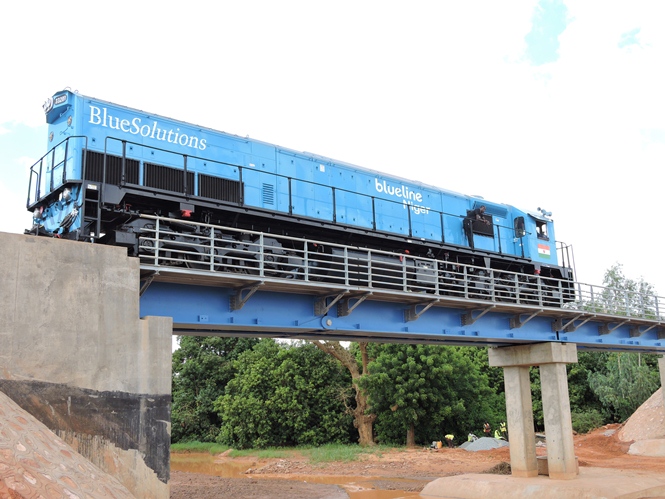The French company Matière first introduced its Unibridge® concept in 2004. Today these patented structures are shipped around the world where they are used as permanent or temporary crossings for vehicles and pedestrians. Thanks to their modular nature and ease of construction, the Unibridge® is particularly popular in remote regions where materials and skilled workers are hard to find. The solution uses ArcelorMittal’s S355K2+N and S460M high strength steel plates which are known for their durability and give the Unibridge® a 100-year design life.
Matière was initially established in 1932 as a pipe-laying business. But in 1983, the company introduced its first pre-cast reinforced concrete structure known as the ‘Conduit Matière’. Ten years later Matière’ acquired a plant in the south-west of France and began making large metallic bridges.
“When Matière began producing metallic bridges in the 1990s, it gave our customers a choice between concrete and metal for the first time,” says Hervé Blanc, Deputy General Manager of Matière. “And it also led to the development of the Unibridge® in 2004.”
“The close cooperation between ArcelorMittal Europe – Flat Products and Arcelor Mittal Projects, together with the quality of the plates produced in ArcelorMittal’s mill in Gijon (Spain) guarantees the best level of service for Matière,” says Michaël Regal, Account Manager for Matière at ArcelorMittal Projects.
Since 2018, heavy plates from Gijon have been successfully delivered to Matière and its subcontractors in France, Belgium, and Portugal. “When a very short lead time is required, we are in the position to offer a delivery in less than a week at any Matière yard thanks to our own stock of plates, beams, and tubes,” says Michaël Regal.
 - Copy.jpg)
The Pont-de-Juba in Sierra-Léone, one of 35 countries where the Unibridge has been deployed [Image © Matière]
The Unibridge® was initially developed as a solution for the military, but was never adopted. Matière immediately saw the potential of the solution in developing countries and remote locations as Hervé Blanc explains: “These areas typically require many bridges, but there is a lack of resources and skills to produce them.”
Ease of transport and construction in remote areas was a key consideration in the early design phase notes Hervé Blanc: “We developed a structure that does not require welding on site and which can be assembled without heavy lifting devices. In some cases, the girders can be offloaded and pushed into place with an excavator, or sometimes by the truck that delivered them. It takes around five days to install a typical two-lane (nine-metre wide) bridge that is 40 metres in length.”
The only preparatory work that needs to be done is preparing the bridge’s abutments. That can be done by an onsite partner who can complete the work while the bridge is being manufactured and shipped.
The Unibridge® can be assembled in remote areas where skilled labour is scarce [Image © Matière]
Matière adapted the design to ensure two of the box girders which form the basis of the Unibridge® could fit into a standard shipping container. “Our box girders are 11.4 metres in length, ensuring two can fit into each container,” says Hervé Blanc. “The girders can be pinned on site to create a maximum length of 60 metres. But if you include piles, you can extend the length of the bridge significantly. We’re currently constructing a Unibridge® in the Philippines which will be four kilometres long. There is no limit on the width of the Unibridge® as the box girders can be simply linked with spacers.”
Another consideration was keeping the weight of the container below 25 tonnes. “Thanks to the use of ArcelorMittal grades such as S460M, weight is not an issue,” says Hervé Blanc. “In the beginning we constructed the entire bridge from S355 and a typical box girder weighed 12 tonnes. Today we are using more S460M, and the average weight is 10 tonnes, a saving of almost 20 percent. Now we are looking at replacing the S355 with S460M from ArcelorMittal to achieve even greater weight savings. That will reduce the cost of transporting and installing the bridges.”

By adding piles, the length of a Unibridge® can be extended almost indefinitely [Image © Matière]
One of the key advantages of ArcelorMittal’s steels is that they don’t need a lot of maintenance as Hervé Blanc explains: “ArcelorMittal’s steels are very tough! The bridge simply needs a fresh coat of paint every 15 to 20 years to protect it. In some areas we recommend a C5 paint system due to the marine environment.”
As the Unibridge® is prefabricated, there is no waste produced on site. All scrap steel produced in Matière’s factories is recycled or reused. The sustainability of the solution is further enhanced as it can be transported by ship from Matière’s plants in Europe.
The bridges themselves can be fully recycled at the end of their life, or disassembled and reconstructed in another location. “The company which is building a traffic deviation around Strasbourg (France) is renting two of our Unibridge® solutions to divert traffic around the roadworks,” says Hervé Blanc. “They will be in place for two years before they are dismantled and reassembled in another location.”
To date, Matière has installed over a thousand Unibridge® solutions in more than 35 countries around the world. “The introduction of the Unibridge® in 2004 was the beginning of Matière’s success story,” says Hervé Blanc. “But every Unibridge® is also a human success story. They can cut a journey that normally takes a day, to just an hour. This dramatically changes the way people in remote areas live and interact.”
Matière was founded in 1932 and is still a family run company. The business operates three plants in France and one in Belgium. All the plants produce components for Matière’s bridge business. In addition to the Unibridge®, Matière produce reinforced and prestressed concrete bridges, metal bridges, and composite structures which use both metal and concrete. The company is also involved in the repair of concrete and metallic bridges.
Matière has 500 employees across 18 subsidiaries. Around 65 percent of its bridges are exported outside Europe.
For more information about Matière, please visit www.matiere-tp.com.jpg)

ArcelorMittal Projects has a global network of offices to support customers wherever their projects are located. We can leverage all parts of the ArcelorMittal group and source steel products from different segments.
We have specialty stocks of steel strategically located around the globe. That enables us to provide a complete and customised range of steel solutions and services, which include dedicated project management and prefabrication.
For more information about ArcelorMittal Projects, please visit projects.arcelormittal.com